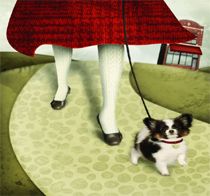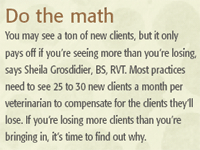Why clients leave
Six pet owners tell their stories about why they left veterinary practices. Learn from their experiences--then use these tips and tools to avoid critical client care mistakes.
The office smelled of urine and pet odors. The surroundings were dirty and depressing." "I received poor service from the receptionists who answer the phones and schedule appointments." "When I picked up my cat, his white underbelly looked grey with dirt." These are just a few of the responses we received when Firstline surveyed pet owners across the United States to ask why they left their veterinary practices.

Now you may be thinking, "This could never happen in our clinic." But don't be too hasty, says Karen Felsted, CPA, MS, DVM, CVPM, a consultant with Gatto McFerson CPAs in Santa Monica, Calif. Stories like these happen in practices every week, she says, so keep an open mind and an open heart to learn from these clients in crisis. Then use the advice from Firstline Editorial Advisory Board members Dr. Felsted, Sheila Grosdidier, BS, RVT, and Sharon DeNayer to head off serious client service gaffes.
They were too busy for me
As Yogi Berra said, "Nobody goes there anymore. It's too crowded." The doctors at the practice we left were excellent, but the front office staff members were overworked and rude. The practice was so successful it was difficult to get an appointment. And when we had an emergency, the front office was uncooperative.
The decision to change veterinary practices was difficult, but we were able to find a veterinarian who works well with pets and has kinder, more supportive team members. The staff worked us in so the doctor saw our female dog the same day when she developed a breathing problem. In a similar situation at the previous veterinary clinic, the receptionist would say, "The next appointment available is in two weeks," and add, "Do you want it or not?"

Write your Mantra
How you can do it better
As your practice grows, you may need to develop new systems to maintain the homey feel that helped you achieve success, says Grosdidier, a partner with VMC Inc. in Evergreen, Colo. Consider these strategies:
Hire a greeter. A greeter's full-time job is to welcome clients. They don't answer phones or sit behind the reception desk. They focus on hospitality, whether it's offering drinks or talking to clients about their pets, grandkids, and softball teams.
Use their names. Every team member should greet clients and pets by name and thank them for taking the time to visit the practice. One trick: Tell clients you want the pet's picture for the medical record, and take their picture with the pet. So when clients walk in the door, there's a good chance you can call them by name. This is a great tool for new team members, too—no matter who's at your front desk, your clients will receive the same warm greeting that becomes a trademark for your practice.
Use emergency and buffer appointments. Plan at least one emergency slot for each veterinarian seeing appointments. Or plan a few buffer slots for clients who perceive an emergency. These are usually 10- to 15-minute blocks in your appointment book. Usually, you'll plan more slots for busy days, like Mondays, Fridays, and Saturdays, and less for slower days, like Thursdays.

Do the math
Encourage drop-offs. The client can leave the pet and the doctor can examine the pet when he or she has time. Then you can call the client when her pet's ready to go home.
Make sure you're staffed appropriately. Perhaps you need more veterinarians, or maybe you need more technicians and the doctors need to delegate more. If your next available appointment is two weeks away or more, decide whether you want to grow to accommodate more clients or close your practice to new patients. Click here for a sample inactive client letter.
They were distracted by visitors
I left a veterinary practice not because of the veterinarian—who seemed fine, if a bit exhausted and overwhelmed—but because of the staff. On many occasions, when I brought my dog to the clinic, a friend of some of the team members brought her 4-year-old daughter to visit. While I was waiting in the reception area, the child appeared to have free reign behind the scenes, where the animals were boarded and recovering. Meanwhile, the team chatted with the visitor at great length. I thought this was unprofessional.
When team members neglected to tell me, a first-time dog owner, I needed to treat my second dog for whipworm because my first dog was infected, I decided to take my business elsewhere. I've been ecstatic with my new veterinarians and their professional team members.

Why I love my vet
How you can do it better
If friends visit, nicely explain you're at work and you can't talk now, says Dr. Felsted. And managers need to step in the first time they notice this behavior. "Ask the team member to excuse herself from the conversation and remind her she's at work," she says. Then consider this advice:
Create a children's area. A few tables and chairs, crayons and coloring books—even a few old computers with age-appropriate games—will keep little ones occupied while they wait. If you have a greeter, he or she can help entertain and involve children and serve as the traffic cop to separate clients who may need more space or privacy.
Make conversational spaces. If you line your chairs against the wall, you've created a stage for kids to act out. The dogs will stare down the cats, and the loud talkers will annoy the client who's trying to watch your television. So create furniture groupings, each consisting of a few chairs and a coffee table, at 90-degree angles. You'll get 25 percent more seating, and you can separate the children's play area from Mrs. Smith and her nervous Persian.
Look at lifestyles. To make sure you identify the recommendations you need to make for the pets in front of you—and the ones that may be at risk at home—use lifestyle summary sheets and wellness checklists. Click here for canine and feline lifestyle summary sheets to tailor your message.
They forgot their compassion
One morning, I sat next to a couple and their dog in the waiting room. They were called into an exam room, then emerged several minutes later crying and carrying the euthanized dog in a black garbage bag. It was extremely disturbing to me and two other people who were also in the reception area.
How you can do it better
"Sending a pet home in a garbage bag sets a negative tone for the practice," Grosdidier says. "Clients notice it, team members notice it, and it ultimately affects the care you give. Remember, respect is what you do more than what you say."
A box or shroud demonstrates a higher level of professionalism, Dr. Felsted adds. Consider these tips to demonstrate you care:
Be discreet. For example, if Mrs. Johnson arrives at the end of the day to euthanize her pet, the receptionist might tell the technician, "Mrs. J is here for the procedure listed in the appointment book." This keeps private information from traveling around the reception area.
Follow your euthanasia protocol. If you don't have one, write one. This document outlines details, such as when you schedule appointments, the preparations, and how much time you'll plan for the event. It also explains how to handle the client's experience compassionately and discreetly, including planning a different exit from the practice so clients don't have to walk back through your reception area, where other clients and pets may be waiting. If you vary from your protocol, consider how your actions will make clients feel and try to minimize their suffering.
Click here for a sample confidentiality pledge
The practice pets rule the roost
I left my veterinary practice because the last time we went, the relief veterinarian's two large dogs were running around the treatment area. My cat hates going to the doctor under the best circumstances, and she wigged out when the two large dogs got close. They started barking, my cat went into hyper-drive, and the team members all started yelling. After we got home, my cat hid under the bed for three days. We now go to a cat-only clinic.
How you can do it better
"Focus all your energy and resources on the pets coming in the door," Grosdidier says. "You want clients to feel comfortable, you want their pets to feel comfortable, and you want to offer a safe, secure environment for your patients." Here's how to make that happen in your practice:
Don't let them roam. When clinic pets wander, your liability skyrockets. Clinic kitties and pups can trip your clients, taunt your nervous patients, and even be at risk themselves. What would you do if Mr. Anderson's rowdy rottweiler decides Fluffy, the clinic cat, looks like a tasty treat?
If your practice pets are an important part of your team's work culture, consider restricting the areas they roam by placing baby gates or screening the door to the doctor's office. This also reduces your risk of spreading zoonotic diseases.
Separate anxious pets and clients. Many cats who don't live with canine companions haven't been exposed to dogs—ever. For these patients, it's nicest to take them straight to an exam room to wait in private.
Schedule smart. Whenever possible, try to group your cat-only appointments. Then block another time for rowdy dogs so clients aren't forced to mingle their cagey cats and powerhouse pups.
Bench chaotic canines. Invest in a few nice benches or a picnic table for your practice lawn. Then offer to call or send a text message to clients who want to take Benji and Rambo for walks or enjoy your outside reception seating. Click here for a pets in the workplace policy.
They made decisions for me
When my cat that I had more than 15 years—longer than I had known my husband—became ill, team members told me I probably needed to put her to sleep. I said I needed to think about it and told them I'd call back a little later in the morning when the veterinarian was there.
When I called back to give the go ahead, I told them I wanted to be there. They told me they'd already euthanized my pet. I was devastated because I didn't want my cat to be alone when it happened. The experience made me feel so much worse. I could never go back to that veterinary practice again.
How you can do it better
When clients are on vacation or otherwise unavailable to sign a euthanasia consent form, consider this advice from Sharon DeNayer, practice manager at Windsor Veterinary Clinic in Windsor, Colo.: When the client gives permission over the phone, ask another team member to listen on an extension. Then document the consent in the pet's medical record.
"Euthanasia is such a terrible experience, so you must be exceptionally careful and handle it well," Dr. Felsted adds. Use this advice when you face clients considering euthanasia:
Know your role. You have four responsibilities in practice: to educate clients, to speak for the pet, to persuade pet owners to offer the care your team recommends, and to be nonjudgmental. It's never a good idea to make decisions for pet owners or judge their choices.
Empathize. The decision to euthanize a pet is possibly the most difficult situation clients face as pet owners. This is an emotionally charged experience—and the care and service you give matters now more than ever.
Document consent for euthanasia. Written consent prevents any misunderstandings that may result in accidental euthanasias—and lawsuits. Click here for a sample euthanasia protocol, a euthanasia consent form, and an advance directive.
They were too rigid
My mother acquired a large, stray rottweiler-lab mix about the same time she was diagnosed with Alzheimer's disease. After Maggie had been with my Mom for a year or two, Maggie got a really bad cut on her paw.
I wasn't sure of the veterinarian's name, and Mom couldn't tell me, so I made an educated guess. The receptionist who took my call that Saturday morning was friendly, and she said, "Of course the veterinarian can see Maggie." Then she asked if Maggie was already a patient. I told her I wasn't sure and explained the situation. The young woman told me if I couldn't tell her that the dog was a patient, the doctor couldn't see Maggie on a Saturday. She made no effort to look up the record, despite my suggestion that she do so.
Instead, I called an animal hospital in the next town. He made room for Maggie. A couple weeks later, after the silly dog dug up a yellow jacket nest and was badly stung, I called the hospital's emergency number to ask whether I could give her an antihistamine. Even though he didn't remember my name or the dog, the veterinarian called me back within five minutes.
He has since become a trusted ally as I manage my Mom's illness and Maggie, who is the only creature keeping my mother focused. The team members are wonderfully sympathetic and kind—I'm not leaving them.
How you can do it better
"Tell clients what you can do," Grosdidier says. "Don't explain what you can't. Perhaps you can use an open emergency slot or refer the client to the local emergency clinic. This pet needs care, so help the client now and sort out the details, like whether she's an existing client, later." These steps will help you put clients' and patients' needs first:
Know which rules to bend. Some rules are written in stone. For example, boarded pets must be vaccinated to protect the pets in your care. Some rules are written in pencil. Review your practice's rules and guidelines and talk about which ones are flexible so you can respond appropriately during emergencies.
Discuss your practice's standards of service. These are your values and your creed. For example, "Our goal is to provide high-quality service and care for clients and patients." Write them on a card and keep it in your pocket. When you face tough decisions, use your practice principles card to guide your way. Click here for a sample practice principles card.
Don't stop here
Perhaps you can think of a few cases in your practice where you made a mistake and lost a client. This is the perfect opportunity to learn from the experience and talk about how you'll prevent problems in the future. "You need to look at all these kinds of client complaints and say, 'What could we do better?'" Dr. Felsted says.
When you face tough client service situations, ask yourself these questions:
- What was the client unhappy about?
- What would have made the client happy?
- Is this something we could have done for the client? Why or why not?
- If not, how could we have communicated better or helped the client find what he or she needed elsewhere?
If clients are leaving your practice, you need to know why—and whether the reasons are within your realm of control. Consider sending a letter to ask why they left or a special offer to entice them back, such as an invitation to visit your open house or to come in for a free bag of food.
"If you don't meet people's needs, most of the time they vote with their feet and leave your practice," Grosdidier says. "If the number of clients leaving your practice is greater than the number coming in, you've got yourself a problem. And I'd want to know what that problem is."
Click here for more true client stories and a discussion guide to role-play scenarios in your practice.
Please send questions or comments to firstline@advanstar.com